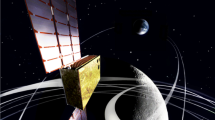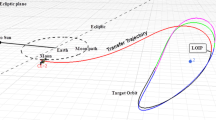Abstract
Orbits about the Sun–Earth L 1 and L 2 libration points have become very popular for space physics and astrophysics missions. Due to the hyperbolicity of the region of phase space where these orbits are found, they are difficult to compute and analyze. The invariant manifold structure provided by dynamical systems theory has been useful to compute transfer trajectories between orbits. These methods are very promising and require further development. This systematic approach is a great improvement from the difficult and labor-intensive numerical search methods currently popular in the astrodynamics community for studying these orbits. The geometric constraints and mission critical issues are discussed to give the numerical dynamical systems community some insight into the practical considerations and important problems of interest to the space mission designers. It is hoped that this communication will lead to more fruitful exchanges between the two communities.
Similar content being viewed by others
References
B. T. Barden, Using stable manifolds to generate transfers in the circular restricted problem of three bodies, MS Thesis, School of Aeronautics and Astronautics, Purdue University, West Lafayette, IN (December 1994).
J. V. Breakwell and J. Brown, The #x2018;Halo' family of three-dimensional periodic orbits in the earthmoon restricted three-body problem, Celestial Mechanics 20 (1979) 389–404.
D. Dunham, A. Seacord and S. Jen, RELICT-2 mission trajectory design, Technical Report, NASA GSFC (May 1992).
P. E. Eliasberg, T. A. Timokhava and M. N. Boyarski, The flight maintenance in the vicinity of a libration center and the one-impulse transfer trajectory to the limited orbit in this region, in: Proceedings of the Second International Symposium on Spacecraft Flight Dynamics, Darmstadt, Germany (October 1986) pp. 55–64.
R. W. Farquhar and A. A. Kamel, Quasi-periodic orbits about the translunar libration points, Celestial Mechanics 7 (1973) 458–473.
R. W. Farquhar, D. P. Muhonen and D. L. Richardson, Mission design for a Halo orbiter of the Earth, in: AIAA/AAS Astrodynamics Conference, San Diego, CA (August 1976) pp. 76–810
K. C. Howell, B. T. Barden and M. W. Lo, Application of dynamical systems theory to trajectory design for a libration point mission, manuscript.
K. C. Howell and H. J. Pernicka, Numerical determination of lissajous trajectories in the restricted three-body problem, Celestial Mechanics 41 (1988) 107–124.
M. W. Lo, K. C. Howell and B. Barden, Mission design for the FIRE and PSI missions, in: AIAA/AAS Astrodynamics Specialist Conference, San Diego, CA (August 1996).
D. L. Richardson, Analytic construction of periodic orbits about the collinear points, Celestial Mechanics 7 (1973) 458–473.
Rodriguez-Canabal, Operational Halo orbit maintenance techniques for SOHO, in: Proceedings of the Second International Symposium on Spacecraft Flight Dynamics, Darmstadt, Germany (October 1986) pp. 71–80.
C. Simó, G. Gómez, J. Libre and R. Martinez, Station keeping of a quasiperiodic Halo orbit using invariant manifolds, in: Proceedings of the Second International Symposium on Spacecraft Flight Dynamics, Darmstadt, Germany (October 1986) pp. 65–70.
V. Szebehely, Theory of Orbits (Academic Press, New York, 1967).
C. G. Zagouras and P. G. Kazantzis, Three dimensional periodic oscillations generating from plane periodic ones around the collinear Lagrangian points, Astrophysics and Space Science 61 (April 1979).
Author information
Authors and Affiliations
Rights and permissions
About this article
Cite this article
Lo, M.W. Libration point trajectory design. Numerical Algorithms 14, 153–164 (1997). https://doi.org/10.1023/A:1019108929089
Issue Date:
DOI: https://doi.org/10.1023/A:1019108929089




